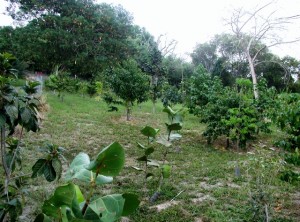
Reforesting Former Pastures in St. Croix, US Virgin Islands
Geographic Consulting specializes in reforestation, forest restoration, and urban tree planting. Land formerly used for agriculture, that is no longer in production, can often become dominated by undesirable plants, or invasive species, such as casha (Acacia spp.), tan tan (Leucaena leucocephala), and plants that are poisonous or unpalatable to livestock.

A typical abandoned pasture in St. Croix. After 15 years of forest regeneration, only two species dominate the site.
Guinea grass (Megathyrsus maximus) often dominates former pastures. It is considered highly invasive by many and is adapted to wildfire. Periodic wildfires kill the regenerating native vegetation, so that forests do not recover without intervention. The role of invasive plants and disturbance in forest succession on St. Croix is described, in part, here.
Our goal is to control the undesirable or invasive plants and alter the wildfire regime by planting native trees. The native trees shade-out the other plants over time and attract the birds and bats that eat their fruit. The animals, in turn, spread the tree seeds and speed up the process of forest succession. Native species such as orange manjack (Cordia rickeskeri), fiddlewood, pigeonberry and many others are well suited for this purpose.

A staging area is cleared in the vegetation using a brushhog mower. Planting lines are cleared off of this staging area.
In order to access a site we make a clearing, usually with a brush hog mounted on a uniloader/skidsteer. We give our trees a temporary competitive advantage by mowing the vegetation around the planting site.
Casha and other shrubs still provide important bird habitat, so we leave much of it in place during the initial planting. Many of these sun-demanding species will be eventually eliminated by the shade of the native trees we plant.
We tend to use large trees, such as saplings in 3 gallon pots. The target plant size will vary depending on the project goals. We stage them in a shady place on site while simultaneously preparing the site for outplanting. (A chapter from (here is a chapter from a recent publication dedicated exclusively to outplanting. The entire publication is available for download and some hard copies may still be available). The holes shown here were created using an 18″ diameter tree-planting auger with a long, tapered tip.
The hole is deeper and twice as wide as the pot and is refilled after the tree is installed. This loosens the soil and facilitates root development.
Geographic Consulting has a certified arborist on the crew to ensure quality installation and our field staff are experienced tree planters. Malformed roots (such as J-roots) are removed and low side branches are pruned to encourage upright growth, above the height of the grass that will regenerate.
We prefer to plant in the rainy season to improved our surviroship rate and decrease the labor required for watering. Regardless of rainfall, watering just a few gallons of water on the day trees are planted significantly increases your success.
We apply only 2 or 3 gallons per tree in harder to access sites, or use tree gators for easily accessible road side trees that require more care.

A mahogany tree is staked and fitted with a water-filled tree gator to help it establish in the challenging environment of a public roadside
Our experience has shown that in only 4 or 5 years, a site can go from this…
to this…
to this…
Contact us and let us help you plan how to transform a scrubby thicket into a healthy native forest.












Comments
i love the work that you do. hands-on saving the island's flora, and building a future for so many species. keep it real!
Thanks, Tomas ! I love it too. We are making happy little forest patches all over the place. Our next job will probably be planting berry producing trees on Buck island !
Comments, Questions? Contact Us.